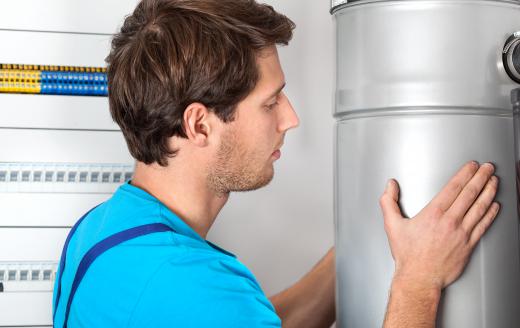What is Radiant Heat Transfer?
Heat can be transferred between two objects by conduction, convection, or radiation. Of these three, only radiant heat transfer does not require a medium to transfer heat. All objects with temperatures above absolute zero give off radiant energy. Radiant heat transfer flows from the warmer object to the colder object. Heat from a campfire is felt without touching the flames. The sun shines and heat travels through empty space, arriving with the strength to burn. The principal of radiant heat transfer, which is that heat can be transferred without direct contact, is successfully used in home heating applications.
Using radiant heat transfer in homes requires an understanding of the heat transfer equation. This equation takes into account the heat transfer coefficient, the surface area of the heat source, and the difference in temperature between the heat source and cooler object. The heat transfer coefficient represents how easily heat can move. If a medium is involved, it is referred to as the thermal conductivity of the material. Surface area of the heat source is important because it determines how much heat can be released at once. Total heat transferred equals the product of the heat transfer coefficient, the surface area, and the temperature difference between the objects.

Finding an appropriate radiant heat source for home heating use is a challenge. Neither a campfire nor the sun can be directly harnessed to create the radiant heating system. Instead, a series of tubes circulating hot water, using radiant heat transfer, can effectively heat a home. The tubes work on the same principal as a hot water bottle warming up bed sheets. Tubes are attached under the subfloor or in the ceiling. Hot water is circulated through the system. Raising the temperature of the water coming from the boiler increases room temperature.
Aluminum radiant heat transfer plates are used to hold the tubing in place. As the tubes warm up, the aluminum plates warm up as well. When aluminum becomes warm it quickly releases, or radiates, heat. The temperature in the home rises from the radiant energy released. The addition of aluminum transfer plates makes the heat even and efficient.
Radiant energy is extremely clean for a home. It does not blow dust, pollen, and other allergens through the air like forced-air systems. Because there is no blower, the system is silent. Heat is simply felt, not heard. There are no furniture placement issues because there are no vents or radiators to work around. The heat provided is extremely even and energy efficient.
AS FEATURED ON:
AS FEATURED ON:











Discuss this Article
Post your comments